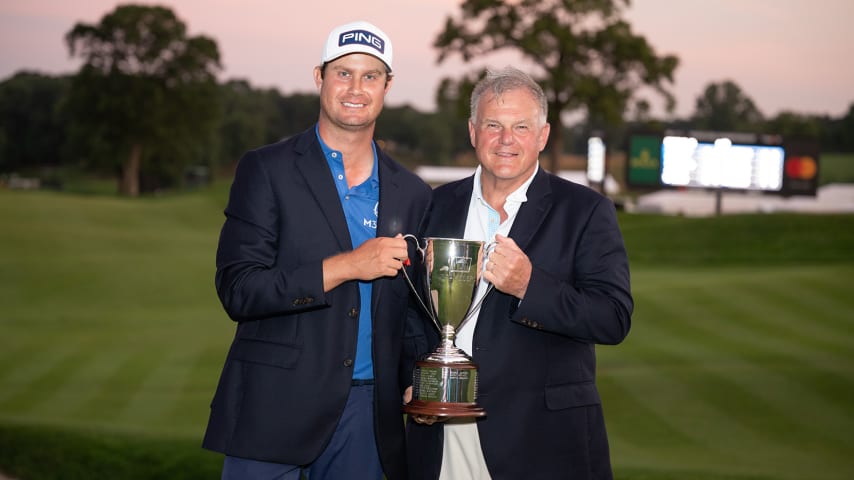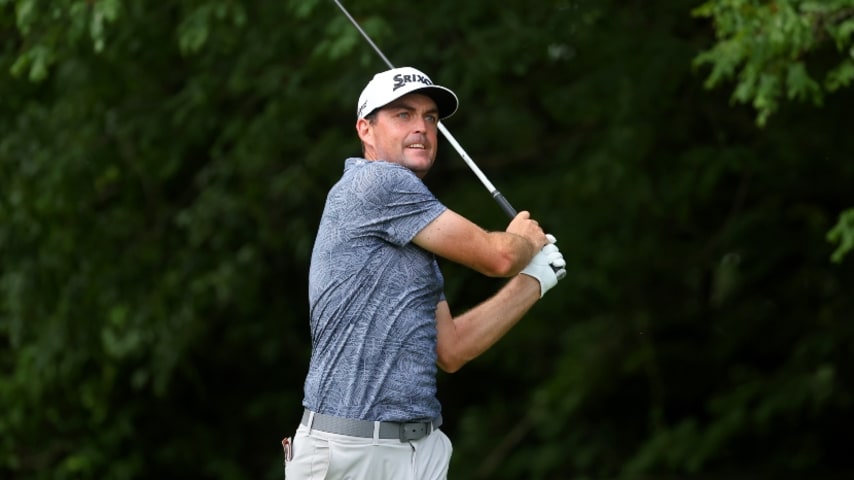Travelers' Bessette uses Olympic experience as impetus to help young pros
8 Min Read

Written by Helen Ross
Andy Bessette loves golf. But try as he might, he knows he can’t hit the caliber of shots he’ll see the PGA TOUR’s best play this week during the Travelers Championship.
He does understand better than most the commitment, training and just plain hard work that goes into being a world-class golfer, though. That’s because Bessette, the EVP and chief administrative officer of Travelers, was a member of the 1980 U.S. Olympic track and field team.
Bessette was a hammer thrower, and his toss of 232 feet, 10 inches to win the trials was a U.S. Olympic qualifying record at the time. But he couldn’t compete in the XXII Summer Games in Moscow when the United States led a 65-nation boycott over Russia’s invasion of Afghanistan.
Bessette doesn’t dwell on that missed opportunity, though. Instead, he prefers to look at all the others he got along the way. The coach in Scotland who helped him move to the next level. The business leaders who gave him full-time pay for part-time work when he was training for the Olympics. Even the man who played in the Boston Symphony Orchestra and gave him those trumpet lessons when he was young.
“Embedded in that entire story is many, many people – and I could name every one of them – who gave me an opportunity to get better and to excel,” Bessette says. “And that's why at the Travelers Championship every year we give three or four of our exemptions to the young kids. …
“I love that. That reminds me so much of what I did, of the people who helped me as I grew as an athlete. To me, it's almost emotional. And so important, so important, as to what we all can do in life is to give young people the opportunity. Now, they either seize it or they don't.”

Bessette seized his chance, just as recent PGA TOUR University grads Ludvig Aberg and Sam Bennett, who both received sponsor’s exemptions this week, are doing. The gregarious Travelers executive grew up in Rhode Island, which at the time was the only state that sanctioned hammer throwing in high school athletics. Bessette, though, was more musically inclined – he played the trumpet and the piano – and sports wasn’t really on his radar screen. That is, until his dentist, whose sons both were hammer throwers, suggested the 6-foot-2, 180-pound 14-year-old think about track and field.
“So, I went to their house, and they taught me how to weight lift,” Bessette recalls. “I said, ‘wow, how'd you get that many trophies?’ And here I am, a freshman in high school. I'm like, ‘whoa, this is really cool.’ … So, I said, ‘I want to try that.’ And it was so much fun.”
Bessette started throwing the hammer when he was a sophomore. His first throws were in the 120-foot range – “which is terrible,” he says. By the time he was a senior in high school, though, he was throwing 200 feet and attracting scholarship offers from the likes of Southern California and the University of Texas-El Paso. He ended up choosing the University of Connecticut over Rhode Island and Worcester Polytechnic Institute because his parents wanted him to stay closer to home.
The transition from a 12- to 16-pound hammer in college proved to be no problem for Bessette. He threw farther than any college freshman ever and qualified to compete in the first USA-USSR international track meet. He became a four-time college All-American – which at the time meant finishing among the top three at the NCAAs, no small feat itself. He worked with other elite athletes who threw the hammer, discus, javelin and shotput at the U.S. Olympic Committee’s developmental camp.
By the time Bessette graduated from college in 1975, he had thrown more than 213 feet. After earning a master’s degree from the University of Rhode Island, Bessette got another boost from the USOC when he was among the first athletes hired into its Olympic Job Opportunities Program, designed to provide full-time employment with flexible schedules for aspiring members of the U.S. Team.
“These two gentlemen, they're both CEOs of big companies, Canteen and Sheraton hotels, called and they said, ‘we're going to hire you,” he recalls. “You're going to work from like seven to noon, and then the rest of the day you go train because we want to beat the Russians.’”
Bessette’s stellar hammer-throwing career “exploded” after college when he went to Scotland to train with national coach, Stewart Togher, who was known for his innovative circuit training approach that involved short bursts of intense exercises like chin-ups, dips and sit-ups. Bessette calls the program “ahead of its time stuff.” He also worked with a yogi and a sports psychologist before it became the norm.
“He taught me how to train, how to become more of a fit athlete,” Bessette says of Togher, who eventually came to the U.S. to work with him. “I was doing burpees and I was doing all kinds of circuit training. It was dips with weights, with plates tied to my waist, and he wouldn't let me weightlift until I passed a certain level in circuit training.”
By the time the Pan-Am Games rolled around in 1979, Bessette was throwing more than 220 feet. He finished fourth, “which I was really proud of, but I was kind of mad because remember back in the early days, I was impressed with the trophies,” Bessette says. Determined to get some of that shiny hardware, he lived in a one-room apartment made out of a converted chicken coop for two years leading up to the Olympic Trials. A panel separated the sleeping and living areas. He cooked on a hot plate or in a toaster oven and shared a bathroom with the man living next door.
“I looked at that because I wanted to be rotten, miserable and to have nothing that I could fall back on that would be comfortable,” recalls Bessette, who was in his “mountain man” phase with long hair and a Fu Manchu moustache. “… You have to always be a little uncomfortable, I think, to be really good.”
Bessette came into the 1980 season throwing farther than he ever had. He won the nationals and then two weeks later, dominated at the Olympic Trials in Eugene, Oregon.
“I beat everybody that day,” he recalls. “And to most amateur athletes, if you can finish in the top three of the Olympic trials and qualify for an Olympic team, that's like the epitome of your life. What you can do at the Olympic Games is gravy and good. But winning the Olympic trials was such a big deal.”
Bessette acknowledges the boycott was devastating, even to this day, “because you always have an asterisk next to your name, even though you did really good.” He harbors no illusions that he or his teammates could have stopped the East Germans or the Russian onslaught, but he’ll never know.
“What did I learn from that? You know, I learned that you don't always control your own destiny in life,” Bessette says. “You work as hard as you can in life. And you just have to appreciate and enjoy the people you are around while you are on the journey.”

The Liberty Bell Classic, a track and field event that attracted athletes from 29 of the boycotting nations, was held in Philadelphia three days after the 1980 Olympics began. Bessette finished third, which he calls “tremendous” and a “nice feeling.” He was an alternate for the 1984 Games before trading the throwing circle for the boardroom at Travelers where he has worked for more than 43 years.
Interestingly, the first international meet the Americans competed in after the 1980 Olympics was in Leningrad, which is now called St. Petersburg – so it was “back to freaking Russia,” Bessette says with a laugh. But he was touched by athletes from other countries who competed in the boycotted Games and brought him souvenirs from the competition.
“I thought this was so special that all of my friends in Russia brought me trinkets from the Olympic Games,” he says. “They weren't jerking me around. They were not trying to be mean. They just knew that athletes were used as pawns in this game and so they brought me gifts.”
These days, Bessette is content to play the piano – and occasionally the trumpet – a couple of times a year. Several years ago, he did get an age-adjusted hammer, went out in a field with his son, Chris, and threw it about 160 feet, which was only about 3 feet short of the national championship for his age group. When his son brought up the Senior Olympics, though, Bessette laughed and told him he’d been there, done that.
This week Bessette is focused on the Travelers Championship, one of the PGA TOUR’s designated events. Just as he appreciated the individuality of his sport, he sees the same singular focus in TOUR’s best. “There’s no wide receiver to go catch my drive off the tee – they’re all out there by themselves,” he says. So, he and his staff work hard to make sure the players have the opportunity to be their best selves this week at TPC River Highlands.
“We have to treat them with respect and appreciation and give the young kids opportunities and let them concentrate on sport,” he says. “Because when the fans come out, they're not coming out to worry about all the issues going on around golf right now. They're coming out to see good athletes, world class athletes, perform at a world class level. And that's what I find so special, because that's all I knew growing up as a young athlete. That's all I knew.”






